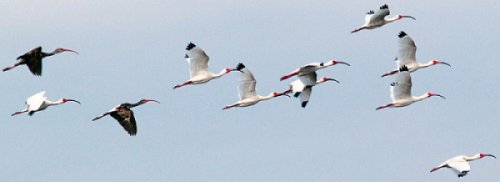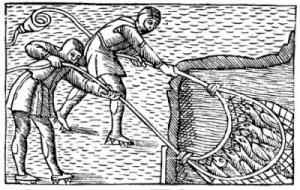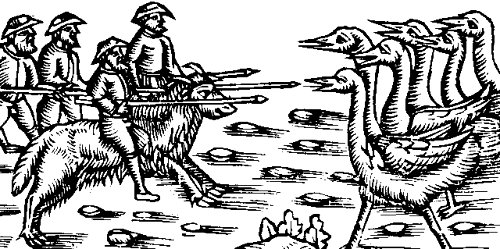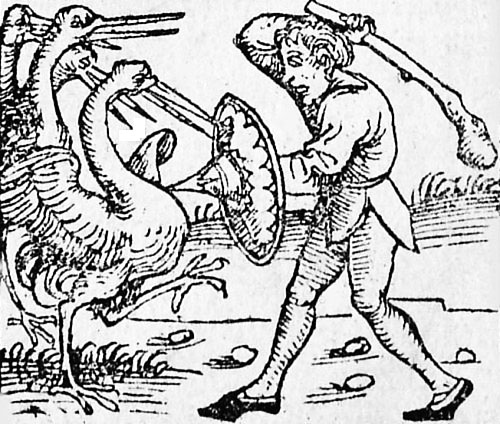Ancient Explanations of Bird Migrations
Today, our guest, classicist Richard Armstrong, watches the ancients studying bird migrations. The University of Houston presents this series about the machines that make our civilization run, and the people whose ingenuity created them.
We humans have long been aware of the seasonal changes in bird populations. But just taking note of the comings and goings of our winged friends hardly answers the question of what they're up to.

For centuries, speculation has risen to the task with sometimes comical results. Aristotle declared that summer Redstarts annually transform themselves into Robins in winter. He also thought summertime Garden Warblers change into Blackcaps. These miraculous transmutations were treated as a matter of fact for hundreds of years, and not just on the authority of Aristotle. Observation seemed to coincide with the explanation in this case: Redstarts migrate to sub-Saharan Africa at a time when Robins, who breed farther north, come to winter in Greece. Since the species were never completely present at the same time, the explanation seemed plausible.
More fanciful was the story of crane migrations. The Common Crane breeds in the marshlands of northern Europe and Asia and makes yearly migrations into Turkey, Iraq, and even down into Sudan and Ethiopia. But, as early as Homer's Iliad, we find the strange notion that cranes are annually at war at the far ends of the earth with Pygmies. In Homer's epic, the Trojan army is compared to the
shriek of cranes down from heaven
who flee the winter and the terrible rains
and fly off to the world's end
bringing death and doom to the Pygmy-men
as they open fierce battle at dawn.
Roman naturalist Pliny the Elder reports an already ancient factoid that these pygmies fight the cranes with arrows while mounted on goats and rams. They must spend a good three months of the year eating the cranes' eggs and chicks; otherwise, they would never survive the terrible onslaught of the birds, Pliny tells us.
Along with transmutation and migration, was a belief in hibernation. Aristotle claimed swallows and kites had been found in holes in the ground, and again, his authority kept this belief alive for centuries.
 We find this idea still viable in a sixteenth-century History and Nature of the Northern Peoples by Swedish Archbishop Olaus Magnus. A woodblock print from 1555 shows fishermen pulling up a net-load of hibernating swallows from a lake. The passage on swallows bristles with elaborate pseudo-information. The swallows congregate in vast numbers in fall, and sink down into the mud and water, packed like sardines. Inexperienced fishermen, Olaus said, will try to warm up these swallows and revive them, but they soon die. Experienced fishermen just leave them undisturbed.
We find this idea still viable in a sixteenth-century History and Nature of the Northern Peoples by Swedish Archbishop Olaus Magnus. A woodblock print from 1555 shows fishermen pulling up a net-load of hibernating swallows from a lake. The passage on swallows bristles with elaborate pseudo-information. The swallows congregate in vast numbers in fall, and sink down into the mud and water, packed like sardines. Inexperienced fishermen, Olaus said, will try to warm up these swallows and revive them, but they soon die. Experienced fishermen just leave them undisturbed.
These explanations lasted because the facts of bird migration are very elusive. With radio transmitters, radar, satellite tracking, and other high-tech devices, scientists have finally uncovered some of the mysteries surrounding the birds' astounding movements across the globe. Early explanations of migration may've often been very wrong; but basic human respect for avian instinct is as old as the Hebrew Bible. Jeremiah observed that:
Even the stork in the sky knows her seasons
And the turtledove, swift, and crane
Keep the time of their coming.
I'm Richard Armstrong, at the University of Houston, where we're interested in the way inventive minds work.
For Aristotle's explanation of species transmutation, see Aristotle, History of Animals VIII (IX) 49b, 632b14-633a28.
On cranes and bird migration in general, see Jonathan Elphick, ed., The Atlas of Bird Migration (Buffalo, NY: Firefly Books, 2007), esp. pp. 96-97. For North American migrations in particular, see Miyoko Chu, Songbird Journeys (New York: Walker & Co., 2007).
The Homer quote is from the Iliad, Book 6, lines 2-7, my translation.
Pliny the Elder, Natural History, tr. by H. Rackham (Cambridge, MA: Harvard UP, 1967, 10 vols.); Book 7, Section 26; and Book 10, Section 30.
Olaus Magnus, Description of the Northern Peoples, tr. Peter Fisher and Humphrey Higgens (London: Hakluyt Society, 1996-), book 19, chapter 29 (vol. 3, pp. 980-981).
Image sources: Bird migration photo by JHL. The fishing for swallows image is from Olaus Magnus's book. Two mages of cranes and pygmies (below) are top: from Olaus Magnus, and bottom from the Nuremberg Chronicles, 1493.

